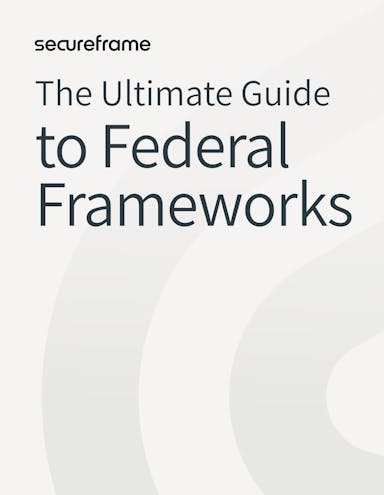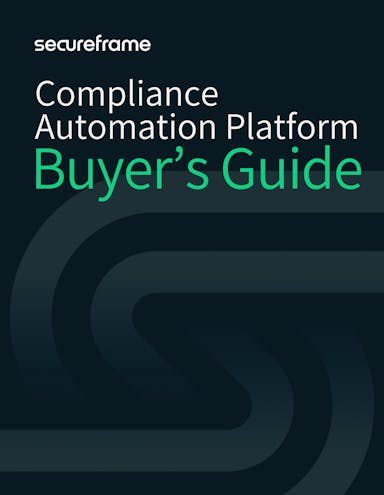
Understanding the NIST Risk Management Framework: A Comprehensive Guide
Anna Fitzgerald
Senior Content Marketing Manager
Cavan Leung
Senior Compliance Manager
Data breaches hit an all-time high in 2023, with many organizations experiencing multiple breaches. In fact, 95% of organizations surveyed by IBM between March 2022 and March 2023 said they had experienced more than one data breach. New cybersecurity risks, including cloud misconfigurations, more sophisticated ransomware, and vendor exploitation attacks, contributed to the increases in data breaches, according to an MIT report.
As the frequency and impact of data breaches and other cyber attacks continue to increase, organizations must implement robust risk management processes to secure a growing attack surface against evolving attack vectors and technologies.
One of the most respected frameworks for managing risks is the NIST Risk Management Framework (RMF). This comprehensive guide will delve into the NIST RMF, exploring its importance, steps, and best practices for implementation.
What is the NIST Risk Management Framework?
Created by the National Institute of Standards and Technology, the RMF is a comprehensive, flexible, repeatable, and measurable 7-step process aimed at integrating security and risk management activities into the system development life cycle. It provides a structured process that ensures information security and risk management are not afterthoughts but integral components of an organization’s overall mission and business processes.
Who does NIST RMF apply to?
NIST RMF can be applied to any type of organization. In addition to federal agencies, state, local, and tribal governments, private sector organizations across industries are encouraged to use this voluntary framework to better manage security and privacy risks.
The benefits of implementing the NIST RMF
NIST RMF is designed to help strengthen the underlying information systems, components, products, and services of any organization.
Implementing NIST RMF offers benefits to all types of organizations, including:
- Standardization: The RMF provides a standardized approach to risk management, ensuring consistency across various departments and systems and alignment with the organization’s mission and business objectives.
- Compliance: By adhering to the RMF, federal agencies satisfy the requirements in the Federal Information Security Modernization Act of 2014 (FISMA), the Privacy Act of 1974, OMB policies, and Federal Information Processing Standards, among other laws, regulations, and policies. Following RMF guidelines also helps federal agencies as well as other organizations implement the NIST Cybersecurity Framework (CSF).
- Security and privacy protections: The RMF ensures that security and privacy considerations are integrated into every phase of the system development life cycle and that appropriate risk response strategies are implemented. This helps achieve security protections for information and information systems and privacy protections for individuals.
- Proactive security and privacy: The RMF’s emphasis on preparation and continuous monitoring promotes a proactive stance toward managing security and privacy risks.
- Risk-based decision-making: By providing a structured approach to risk assessment, the RMF aids in better decision-making regarding resource allocation and risk mitigation strategies.
- Tailored risk management: Encouraging the tailoring of controls ensures they are relevant and effective for the specific organizational context.

The Ultimate Guide to Federal Frameworks
Get an overview of the most common federal frameworks, who they apply to, and what their requirements are.
NIST 800-37 Rev 2
The RMF is detailed in NIST Special Publication 800-37, “Guide for Applying the Risk Management Framework to Federal Information Systems.” The latest version, NIST 800-37 Revision 2, builds on the foundation established by Revision 1, offering a more comprehensive and integrated approach to risk management.
Key changes in Revision 2 include:
- The introduction of the Prepare step: The "Prepare" step was introduced in the updated version of the NIST Risk Management Framework, detailed in NIST Special Publication 800-37 Revision 2. This step aims to facilitate more effective, efficient, and cost-effective security and privacy risk management processes by laying the groundwork for the subsequent RMF steps.
- The integration of privacy: Revision 1 focused primarily on information security. Recognizing the growing importance of privacy, Revision 2 integrates privacy risk management processes into the RMF to ensure organizations are building privacy protections into the risk management process alongside security. This includes identifying privacy risks and implementing controls to mitigate these risks.
- The integration of supply chain risk management: Revision 2 also integrates security-related, supply chain risk management (SCRM) concepts into the RMF. This addition recognizes that supply chain risk is a growing concern to organizations as they increasingly rely on third-party providers and commercial off-the-shelf products, services and systems.
- Alignment with other NIST frameworks: Revision 2 aligns more closely with other NIST frameworks, such as NIST CSF and NIST Privacy Framework, to provide a more cohesive approach to risk management that can be applied across different sectors and frameworks.
Recommended reading

Supply Chain Risk Management: A Breakdown of the Process + Policy Template
NIST Risk Management Framework steps
The NIST RMF consists of seven steps that are critical to the framework's overall effectiveness. Below you’ll find an overview of each step, including its purpose and series of associated tasks.
Each list of tasks is not exhaustive. You can find a complete list of tasks as well as expected outcomes in NIST SP 800-37.
Please note that the steps below are not numbered because after the Prepare step, the steps can be carried out in non sequential order — although organizations typically do follow the sequential order.
Prepare
Purpose: Establish a context and priorities for managing security and privacy risk and carry out other essential activities in order to enhance organizational readiness for subsequent RMF activities.
Key tasks:
- Assign roles and responsibilities for risk management processes.
- Establish a risk management strategy and organizational risk tolerance.
- Conduct an organization-wide risk assessment.
- Identify, document, and publish organization-wide common controls.
- Develop and implement an organization-wide strategy for continuous monitoring.
Categorize
Purpose: Categorize the organizational system based on the potential adverse impact resulting from the loss of confidentiality, integrity, and availability of the information processed, stored, and transmitted by the system.
Key tasks:
- Document the characteristics of the system.
- Categorize the system using impact levels (low, moderate, or high) determined for each information type and security objective.
- Review and approve the security categorization.
Select
Purpose: Select tailor, and document appropriate controls based on the system categorization.
Key tasks:
- Identify baseline controls from NIST SP 800-53, or use your own selection process to select controls.
- Tailor the controls you’ve selected based on factors such as the organizational mission, business functions, threats, security and privacy risks, type of system, or risk tolerance.
- Designate controls as system-specific, hybrid, or common and allocate them to the appropriate system elements.
- Document the controls in security and privacy plans or a single consolidated plan.
- Develop a strategy for continuous monitoring.
- Review and approve the security and privacy plan(s).
Recommended reading

NIST 800-53 Compliance: What Is It & How to Achieve It [+ Checklist]
Implement
Purpose: Implement the security and privacy controls and describe how they’re employed within the information system.
Key tasks:
- Implement the controls as described in the security and privacy plan(s).
- Document the implementation details, including any changes to planned inputs, expected behavior, and expected outputs.
Assess
Purpose: Evaluate the security controls to ensure they are correctly implemented and effective.
Key tasks:
- Select an individual or team with the necessary technical expertise and independence to assess the controls.
- Develop, review, and approve the security and privacy assessment plan.
- Conduct the assessment in accordance with the assessment plan.
- Document the assessment results, including findings and recommendations for correcting any deficiencies in the implemented controls.
- Prepare the plan of action and milestones (POA&M) based on the assessment results.
Authorize
Purpose: Authorize the system to operate based on a determination that the risk to
organizational operations and assets, individuals, other organizations, and the Nation is
acceptable.
Key tasks:
- Prepare and submit the authorization package, including the security and privacy assessment plans and reports, POA&Ms, and executive summary.
- Finalize the risk determination.
- Identify and implement responses to the risk determined.
- Grant or deny authorization for the information system to operate based on the risk assessment.
- Report authorization decisions and any significant deficiencies and risks to organizational officials.
Monitor
Purpose: Continuously monitor the security controls and information system to ensure ongoing effectiveness and address new risks.
Key tasks:
- Monitor the information system as well as its environment of operation for any changes that may affect its security and privacy posture.
- Conduct ongoing assessments and monitoring to ensure control effectiveness.
- Respond to risk based on the results of continuous monitoring activities, risk assessments, and any outstanding items in POA&Ms.
- Report the security and privacy posture of the system based on the results of monitoring activities on an ongoing basis.
- Review the security and privacy posture of the system on an ongoing basis to determine that risk remains acceptable.
- Update security documentation as needed.
Recommended reading

7 Benefits of Continuous Monitoring & How Automation Can Maximize Impact
Best Practices for Implementing the NIST RMF
The tips below can help simplify and improve the effectiveness of implementing the RMF.
- Early and continuous integration: Integrate the RMF process early in the system development life cycle (SDLC) and maintain continuous involvement throughout.
- Stakeholder engagement: Involve stakeholders from various departments to ensure comprehensive risk management and buy-in.
- Thorough documentation: Maintain detailed documentation at each step to provide a clear audit trail and support ongoing risk management.
- Regular training: Ensure staff is regularly trained on RMF processes and updates to maintain a high level of expertise and awareness.
- Common controls: Use common controls whenever possible to promote standardized, consistent, and cost-effective control implementation across information systems.
- Leverage automation: Use automated tools for control selection, assessment, and monitoring and wherever else possible to increase the speed, effectiveness, and efficiency of executing the steps in the RMF. Automated continuous monitoring in particular can help reduce the cost and increase the efficiency of your security and privacy programs.

Compliance Automation Platform Buyer’s Guide
Learn how a compliance automation platform can help streamline and scale your security and compliance efforts, then use a scorecard to fast-track the vendor evaluation process.
How the NIST AI RMF complements the NIST RMF
As organizations increasingly integrate artificial intelligence into their operations, the risks associated with AI systems demand a new approach. While the NIST Risk Management Framework (RMF) provides a solid foundation for cybersecurity risk management across information technology systems, it doesn’t fully address the complex challenges presented by AI.
To close this gap, NIST developed the Artificial Intelligence Risk Management Framework (AI RMF). First published in 2023 and available on nist.gov, the AI RMF is a voluntary framework designed to help organizations across all sectors develop and deploy trustworthy AI systems. It complements traditional risk management programs by providing a methodology tailored to the ethical, technical, and societal implications of AI.
Where the NIST RMF focuses on securing traditional information systems, the AI RMF addresses AI-specific risks across the entire lifecycle of the technology, from design and development to deployment and use. This AI risk management framework is especially valuable for organizations that use AI to support information technology operations, enhance incident response, or automate decision-making processes.
The AI RMF is structured around four core functions that align with the RMF’s risk-based approach to managing system security and vulnerabilities:
- Govern: Define roles, responsibilities, and oversight mechanisms to ensure accountability for AI risk.
- Map: Identify and document how the AI system operates, what data it uses, and what potential security risks or impacts it may introduce.
- Measure: Evaluate performance and trustworthiness using objective benchmarks and metrics, supporting effective security controls assessment.
- Manage: Implement risk response strategies and continuously refine controls to address emerging threats and unanticipated behavior.
These core functions offer a structured methodology for understanding and mitigating the unique security risks posed by AI technologies. They also promote alignment with broader organizational goals and existing cybersecurity risk management frameworks like the NIST RMF and NIST Cybersecurity Framework.
To support adoption, NIST has released additional resources, including the AI RMF Playbook, which offers suggested actions and documentation practices for each core function, and the Generative AI Profile, which outlines specific risks related to generative AI. Together, these NIST publications help organizations operationalize the AI RMF and strengthen their overall approach to managing risk in information technology environments.
As AI capabilities continue to evolve, incorporating both the NIST RMF and AI RMF can help organizations build a strong and proactive risk management program that accounts for both traditional and emerging threats.
Recommended reading

The NIST AI RMF: What It Is and How to Put It Into Practice
Simplifying NIST RMF compliance with Secureframe
The NIST Risk Management Framework is a vital tool for organizations aiming to manage information system risks effectively. By following its guidelines, organizations can put comprehensive security measures in place and proactively manage risks.
Secureframe can streamline the implementation process, helping organizations save time, reduce costs, and improve their risk management practices.
Secureframe customers can:
- Create a custom framework to apply the RMF to their information system and organization and map our pre-built controls and tests to that framework
- Automatically collect evidence to simplify internal and external assessments
- Continuously monitor their security controls to ensure they’re effective
- Map common controls to multiple framework requirements to reduce duplicate work
- Use Comply AI to automate risk assessments and test remediation
- Link mitigating controls and attach documents to show how you are reducing risk
- Access and customize templates including SSPs, POA&M documents, Separations of Duties Matrix, and more
- Monitor third parties with access to sensitive data in one platform
To learn more about how Secureframe streamlines security and privacy compliance, schedule a demo with a product expert.
Use trust to accelerate growth
FAQs
What is the NIST Risk Management Framework (RMF)?
The NIST RMF is a comprehensive but flexible, 7-step process for integrating security, privacy, and cyber supply chain risk management activities into the system development life cycle. It provides guidelines to help organizations manage information security and privacy risks effectively, ensuring that these considerations are incorporated into every phase of system development and operation.
What are the steps in the NIST RMF?
The NIST RMF consists of seven steps:
1. Prepare: Establish a foundation for subsequent RMF steps by defining roles, strategies, and conducting organization-level risk assessments.
2. Categorize: Categorize the system and information processed, stored, and transmitted based on an impact analysis.
3. Select: Select appropriate security and privacy controls based on the system's categorization.
4. Implement: Implement the selected controls within the information system.
5. Assess: Assess the controls to ensure they are correctly implemented and effective.
6. Authorize: Make a risk-based decision to authorize the system to operate.
7. Monitor: Continuously monitor the system and its controls to ensure ongoing effectiveness and address new risks.
What is the purpose of the Prepare step introduced in NIST SP 800-37 Revision 2?
The purpose of the Prepare step is to carry out essential risk management tasks to establish context and help prepare the organization to manage its security and privacy risks using the NIST Risk Management Framework. It was introduced in NIST SP 800-37 to help organizations achieve more effective, efficient, and cost-effective security and privacy risk management processes.
How does NIST SP 800-37 Revision 2 integrate privacy into the RMF?
Revision 2 emphasizes the integration of privacy risk management alongside security in the RMF process. In Revision 2, identifying privacy risks, implementing controls to mitigate these risks, and ensuring privacy considerations are addressed throughout the RMF process. This integration helps organizations manage both security and privacy risks comprehensively.
What is Supply Chain Risk Management (SCRM) in the context of the RMF?
SCRM involves identifying, assessing, and managing risks that arise from the supply chain, which can impact the security and privacy of information systems. Revision 2 of NIST SP 800-37 incorporates SCRM by encouraging organizations to consider supply chain risks during all RMF steps.
Is the NIST RMF applicable only to federal agencies?
While the NIST RMF was initially developed for federal agencies, its guidelines are widely applicable across various industries and sectors. Many private sector organizations, state and local governments, and international entities adopt the RMF to manage information security and privacy risks effectively.
How does continuous monitoring fit into the RMF?
Continuous monitoring is a critical component of the RMF, ensuring that security and privacy controls remain effective over time. This process involves ongoing assessments, real-time risk management, and regular reporting to detect and respond to changes in the threat landscape and organizational context.

Anna Fitzgerald
Senior Content Marketing Manager
Anna Fitzgerald is a digital and product marketing professional with nearly a decade of experience delivering high-quality content across highly regulated and technical industries, including healthcare, web development, and cybersecurity compliance. At Secureframe, she specializes in translating complex regulatory frameworks—such as CMMC, FedRAMP, NIST, and SOC 2—into practical resources that help organizations of all sizes and maturity levels meet evolving compliance requirements and improve their overall risk management strategy.

Cavan Leung
Senior Compliance Manager
Cavan Leung, CSSK, CISA, CISSP is an information security leader with over a decade of experience in the security, privacy, and compliance industries. A former auditor and security consultant, Cavan performed ERP and SOX compliance audits at Deloitte, as well as SOC 1, SOC 2, GDPR, and ISO 27001 compliance assessments for Fortune 500 companies at Schellman. At Secureframe, he’s helped hundreds of customers achieve compliance with SOC 2, ISO 27001, GDPR, HIPAA, and more.